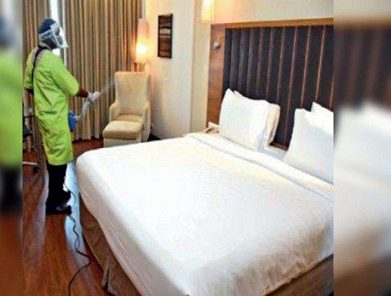The Lalit Great Eastern, one of the oldest luxury hotels in Asia, turned into a Covid care centre on Wednesday. The 100-bed satellite centre attached to AMRI Hospitals will cater to mildly symptomatic Covid-19 patients. Struggling to tide over hospital bed emergency, many hospitals are converting hotels, stadia and community halls into Covid facilities. But this is the first hotel with heritage legacy, which had hosted Queen Elizabeth and American author Mark Twain, to turn into a Covid facility. Patient admission began late Wednesday afternoon with 24X7 nursing care, doctors, oxygen support, Wi-Fi and customised diet plans based on the advice of dieticians. If the need arises, the number of beds can be scaled up.
Patient admission began late Wednesday afternoon with 24X7 nursing care, doctors, oxygen support, Wi-Fi and customised diet plans based on the advice of dieticians. If the need arises, the number of beds can be scaled up.
“We are proud to have opened our satellite centre at The Lalit Great Eastern, which is one of the most prestigious and heritage hotels, where mildly symptomatic patients will be able to stay comfortably. The facility is equipped with round-the-clock nursing support and doctors on site, along with all emergency medicines, oxygen support and necessary consumables. This is the fourth hotel that we have converted into a satellite facility as part of our endeavour to fight the virus and treat Covid patients,” said Rupak Barua, Group CEO, AMRI Hospitals.
The hotel, during the lockdown last year, had offered to have rooms for doctors at the behest of the state government. This time, while one of the wings have been converted into a Covid care centre, the other wing that has separate entry and exit can continue to cater to guests.
“AMRI Hospitals was the first to approach us right after health secretary met the hotel representatives. Looking at the gravity of this unprecedented situation, we readily agreed to support and play our role the way we did by accommodating doctors during the lockdown,” said Dipil Mishra, general manager at The Lalit Great Eastern.
At the facility, AMRI Hospitals has also introduced Dozee Pro, the latest in remote patient monitoring system. The Dozee Pro is a mat, connected to sensors and a pulse oximeter, which is installed under the mattress of each bed, and will help monitor the vitals of all the patients. The system notes changes in a patient’s vitals through the patient’s physical vibrations and sends out signals to a laptop at the nursing station, from where nurses and doctors will be able to keep an eye on the condition of a patient.

